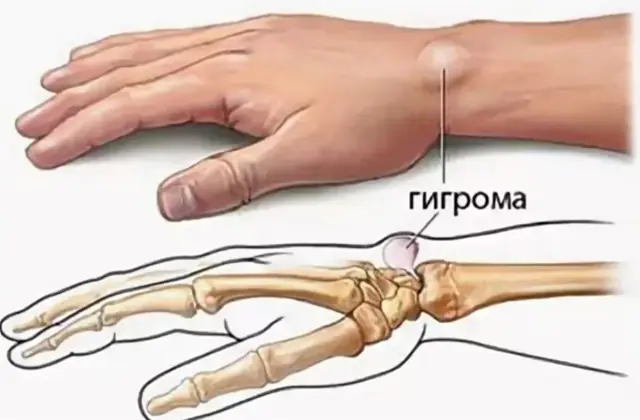
What is hygroma in a child, causes and symptoms. Types of disease and diagnosis. Traditional and surgical methods of treatment, folk recipes, prevention.
The content of the article:- What is hygroma in children
- Causes
- Developmental symptoms
- Treatment options
- Medicines
- Physiotherapy
- Surgical intervention
- Folk remedies
- Prevention
Hygroma in a child is a capsule-shaped tumor with connective tissue walls filled with serous fluid. The most common cause of the disease is injuries to the joints and tendons. In this regard, hygromas often occur in active children involved in sports and other active activities.
What is hygroma in children?

Hygroma is a tumor that occurs near a joint (see the photo to see what it looks like). It is formed in the joint capsule and is a cavity containing rare or viscous fluid. The hygroma is soft and jelly-like to the touch. Being small in size, it does not disturb or interfere with the movement of the joint.
Important! The ganglion (hygroma) does not develop into a malignant tumor.In children, education can occur at any age. But it happens more often in younger schoolchildren and teenagers. The cyst can be located anywhere on the body in the joint area, but its “favorite” location remains the hands and knees.
The types of ganglion are determined by its location on the body. Typically the disease develops in the area of joints or tendons:
- Wrist hygroma in children. The most common location of the tumor in children. From the outside, the cyst is less noticeable, usually small in size. From the side of the palm where the ligament is located, the formation is more noticeable. It is softer and takes on larger sizes. As the cyst grows, it interferes with blood circulation in the hand and limits motor activity.
- Knee hygroma in a child or Baker's cyst. Cases of the development of the disease in children under the knee joint are no less rare. During walking and training, the knee is regularly injured, which can lead to the formation of a cyst. The formation does not immediately become noticeable; when pressed, it goes into the joint cavity. Parents discover a ganglion in the baby when the child complains of pain in the knees during movement and muscle weakness.
- Hygroma on a child's leg. It can form not only under the knee, but also in the ankle area. This localization is rarer, and the cyst immediately becomes noticeable. Ankle tumors are painful and cause concern, so they are diagnosed earlier.
- Hygroma of the foot in children. It often occurs due to wearing uncomfortable shoes or trauma. The most common location is on the outside of the phalanges. The tumor is painful, makes it difficult to wear shoes, and worries the child. Much less often, cysts form on the side of the sole.
- Hygroma on fingers. If the baby has injured his fingers in the recent past or overexerted them, a tumor may form on the back or palm side. Since there is almost no soft tissue in this area, the cyst is close to the surface of the skin and, as it grows, compresses the nerves. The child feels numb, the fingers refuse to move and obey.
- Hygroma in the neck or face area. Ganglia in the neck, back of the head or temporal region are considered one of the most dangerous. They are located near vital vessels. By squeezing them, hygromas disrupt cerebral circulation, which creates a risk of death.
- Subdural hygroma. Occurs in the brain and is a consequence of cranial injuries. The younger the child, the more dangerous the disease is for him. At the first symptoms of brain compression, call an ambulance.
Causes of hygroma in a child
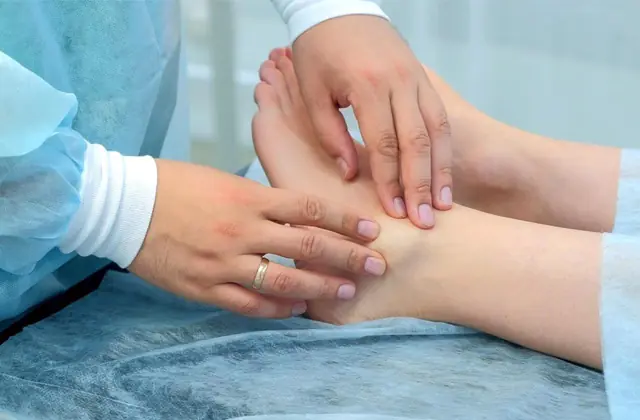
Doctors call injuries the main cause of hygroma in children. The disease affects children from 6 to 10 years old, who often play outdoor games in the yard and attend sports clubs. They regularly receive bruises and muscle strains, which, under favorable conditions, provoke the formation of a tumor.
But if a child is used to sitting in front of a computer or TV for a long time, the risk of developing a ganglion after an injury is no less. The joints and tendons of such children are untrained and are easily damaged at the slightest load.
As a result of bruises, fractures, and sprains, a hygroma can form in any child. An additional factor that stimulates the formation of cysts is heredity. If relatives or parents suffered from such a pathology, the predisposition remains, and the baby may also develop hygroma under favorable conditions.
Less commonly, the cause of the disease is an inflammatory process in the joints against the background of rheumatism, childhood arthritis, and bursitis. Sometimes hygroma on the foot is caused by uncomfortable shoes.
The process of tumor formation depends on what is injured: a joint or a tendon. If the fibrous joint membrane is damaged, the synovial membrane emerges through the resulting crack. It gradually fills with fluid consisting of lymph, protein compounds, mucus and blood. Such a cyst is called synovial.
If the tendon sheath is damaged, a capsule forms from the released areas of connective tissue. Such a cyst is called myxoid. It also fills with liquid and gradually thickens.
The type of cystic formation does not affect the symptoms and treatment of the disease. But in the future, it will be easier for parents to understand what preventative measures to take to protect their child from relapses and new tumors.
Symptoms of hygroma development in a child
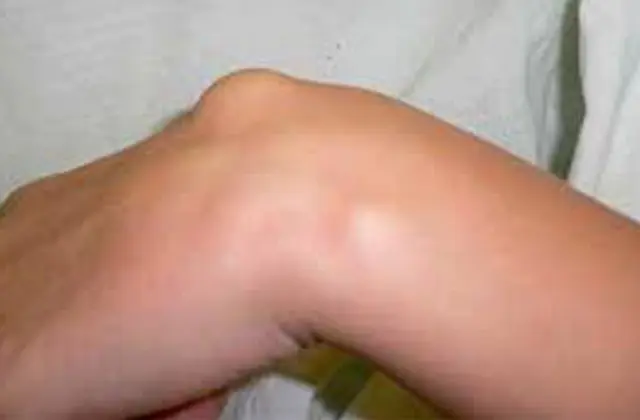
At the very beginning of the development of the disease, the baby does not complain of pain or discomfort. In the area of the diseased joint, barely noticeable swelling and compaction may occur. If the child does not detect the tumor himself, adults may not notice it.
Gradually, the cyst grows and puts pressure on nearby nerves, blood vessels, and tissues. The baby begins to feel pain and complains of discomfort. As a rule, during this period the tumor is easily distinguishable, and parents seek help from a doctor.
There is no point in delaying going to the doctor. Cysts form in the most unexpected places and sometimes threaten the child’s life. For example, a tumor on the back of the head compresses blood vessels leading to the brain. This location of the formation is dangerous due to the death of brain cells, slowing down the overall development of the baby and even death.
Parents should be attentive to their child’s complaints about the following symptoms:
- nagging, pressing pain in the area of the joint;
- the formation of swelling or sac-like formation up to 6 cm in size;
- flaky skin over the cyst;
- redness of nearby tissues;
- numbness of the limbs.
The ganglion is soft to the touch, similar to jelly; when touched, the skin over it moves easily. But there are also hard cysts that resemble cartilage. The size of the tumor is not constant, it grows, enlarges, and becomes denser over time.
Normally, a small formation does not bother the baby. But when you press on the “bump,” the child may feel pain. It occurs when the hygroma compresses the nerves located near the cyst. If parents ignore the baby’s complaints, the disease is subsequently complicated by limited movements, numbness and weakness of the limbs.
Ganglia that form in the meninges are considered especially dangerous.
Symptoms of hygroma are:
- fainting;
- nausea;
- hearing impairment;
- deterioration of vision, speech;
- convulsions;
- lack of coordination.
A visual examination and history taking with the help of parents is not enough for the doctor to make a diagnosis. Before removing a hygroma from a child, the doctor must make sure that he is dealing with a hygroma and not other types of tumors.
For differential diagnosis, instrumental studies are prescribed by exclusion: X-rays, ultrasound scanning, MRI. Puncture of the ganglion is carried out in extreme cases, when it is necessary to determine the composition of the contents.
Methods for treating hygroma in children
Drug treatment of formation with ointments and oral medications is used only to eliminate symptoms. The main treatment for hygroma in a child is surgical removal of the tumor. Before choosing a method of dealing with a cyst, the doctor evaluates its location, size, and pain.
Medicines for the treatment of hygroma in a child
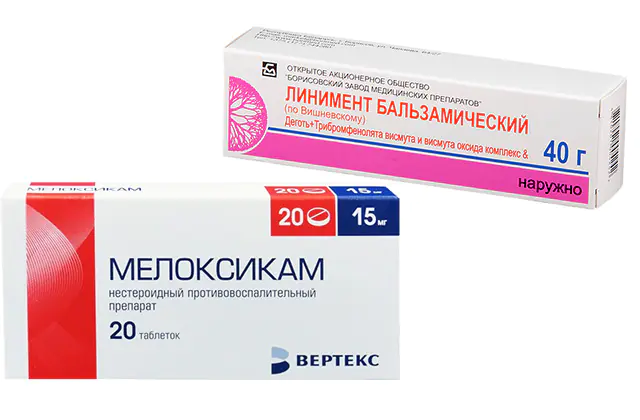
In children, in 50% of cases, hygroma resolves on its own and goes away over time. This happens as the child grows and hormonal levels change. The situation is typical for small entities.
In children under 1 year of age, doctors prefer not to touch the tumor if it is on the extremities and does not affect vital arteries and nerves.
In older children, in order to speed up the healing process, it is recommended to apply Vishnevsky ointment or painkillers, for example, Meloxicam (price - 100 rubles or 40 hryvnia), to the cyst. They relieve inflammation and draw out the fluid inside.
If a child has weak joints, bruises and fractures often occur; chondroprotectors are prescribed to strengthen bone and cartilage tissue. Children are recommended Chondroitin (450 rubles or 170 hryvnia), vitamin complexes with calcium.
Physiotherapy for the treatment of hygroma in a child

Pictured is shock wave therapy for the treatment of hygroma
How to treat hygroma in children depends on how large the formation is. If it is insignificant, it is enough to slow down its growth with the help of physiotherapy.
Children are recommended:
- electrophoresis with antibiotics to eliminate or prevent inflammation;
- hand and foot massage (infants receive a full body massage);
- ultraviolet;
- mud baths;
- shock wave therapy.
Methods of conservative therapy also include puncture, which is a puncture of the cyst with sampling of the contents. Medications are injected into the formed cavity to prevent relapse.
Important! Traditional methods do not completely eliminate the risk of re-formation of hygroma. In this regard, surgical intervention is often required, especially if the tumor threatens the child’s life.Surgical intervention for hygroma in children
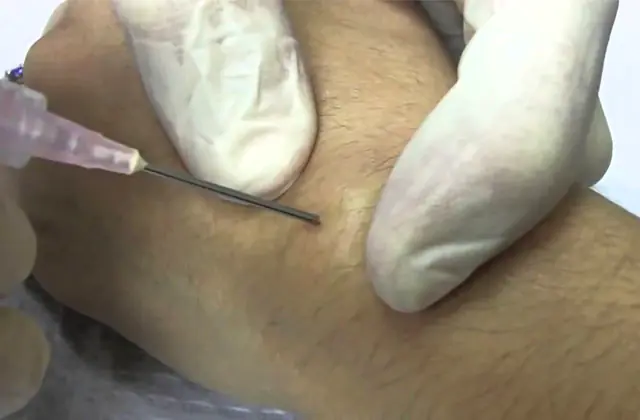
The most progressive methods of dealing with ganglia are the endoscopic method of removing the formation and the use of a laser beam.
Endoscopic surgery is performed under local anesthesia in children over 10 years of age, and under general anesthesia in younger children. A puncture is made on the skin in the area of formation. Through it, microscopic instruments and a camera with a light source are introduced. The progress of the surgical intervention is monitored on the monitor screen. The surgeon uses micro-instruments to separate the cyst capsule from the surrounding skin. The base of the tumor is tightened and sutures are placed. The operation is simple and well tolerated by children.
Another option is laser removal. Through the incision, the surgeon pulls out the capsule with forceps and cuts it off with a laser. The advantage of the method is that the laser beam scleroses small vessels and prevents bleeding. It has antiseptic properties and prevents infection during surgery.
After the tumor is removed, the child is given a sterile dressing. If the cyst was in the joint area, a plaster cast is required to immobilize it. After a couple of days, it is removed and parents are advised to do simple gymnastics with the baby. It is necessary to prevent the formation of adhesions.
Important! Babies may complain of pain during exercise. Encourage the children to bear with it. While postoperative adhesions are soft, they are easy to break. Leaving a joint immobile can result in limited activity.Folk remedies against hygroma in children

Self-treatment of a ganglion in a child is dangerous to health. It is necessary to consult a doctor and determine whether it is definitely a hygroma. If the diagnosis is confirmed, consult your doctor about the use of the following medications:
- Cabbage juice. Pass the white cabbage through a meat grinder and squeeze the juice out of the pulp. Give your child a third of a glass of it before meals.
- Tea mushroom. Make compresses from the crushed body of the mushroom, applying it to the tumor.
- Aloe honey. Mix honey and aloe leaf juice in half. Add some rye flour to make a soft dough. Make a cake out of it and apply it to the cyst overnight. Tie with cloth and woolen bandage.
- Honey with cabbage. Brush a cabbage leaf with honey and apply it to the ganglion, tying it with a cloth.
The recipes given are painless and will not harm the baby’s health.
Prevention of hygroma in a child
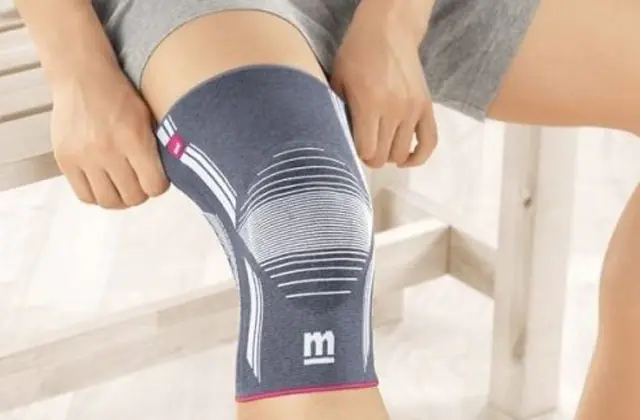
In young children, the disease is difficult to prevent: doctors still cannot name the exact reason for its formation. But parents can reduce the risk of developing the disease by following certain rules.
Hygroma prevention measures:
- Make sure that the child does not injure himself or overstrain his joints.
- For training, buy knee pads and elbow pads that will soften the blows.
- Choose shoes made from natural materials for children, according to age and size.
- If your baby complains of pain in the joints and muscles, have him examined by a doctor regularly.
Knowing what to do in case of hygroma in a child, parents can prevent complications of the disease. Timely diagnosis makes it easy to remove the cyst and take measures to prevent relapse.
Video about hand hygroma and getting rid of it:



